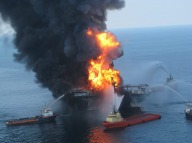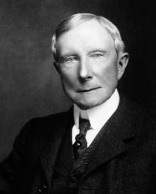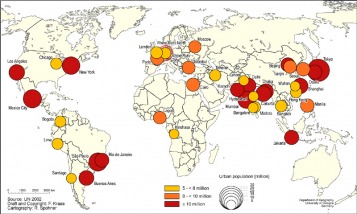 Mr. President, if our shores were being attacked, you would not rely on profiteers and mercenaries to defend us. You would appoint our best General to lead the defense, and you would support him with our best troops. You would not "supervise" private companies and "approve" their decisions. You would appoint one person with authority to make all decisions, and that person would have undivided loyalty to you as President.
Well, our shores are under attack. By the worst man-made environmental catastrophe in history. Eleven people have died, untold thousands are losing their livelihoods, and the damage may haunt us for generations.
The first thing you must do is appoint a battle-tested General and call up the troops. Call the oil companies and tell them that you are drafting all of their top scientists and engineers. You want them in the gulf tomorrow morning. They will no longer report to the oil companies. Until this catastrophe ends, the scientists and engineers will report solely to a chain of command headed by General Petraeus who will be advised by Energy Secretary Chu.
They will not work only on plugging the blowout. They will also do everything possible to protect the people of this nation from the devastating effects of the blowout -- even if that means doing things that will increase BP's costs or reduce its future profits.
General Petraeus knows how to organize and lead people. He knows how to get things done. He will not be distracted by falling stock prices, profit and loss statements, or corporate lawyers advising on potential future liabilities. He will not increase the number of people cleaning the beach when the press is around, and then send them home without finishing the job when the press follows you back to Chicago or the White House. With General Petraeus in charge, you (and the American people) will be confidant that everything is being done with the sole objective of protecting our nation and its people.
Mr. President, you have said that we need the oil industry's superior expertise in deepwater oil drilling. That may be the case. But this is not about expertise. This is about leadership. It is not enough for you to "supervise" or "approve" everything that BP does.
We know from experience what happens when war profiteers and mercenaries like Halliburton and Blackwater make decisions subject to the "supervision" and "approval" of the US government. The profiteers make billions and the national interest is not well served.
You must relieve BP and all of its corporate officers from any authority to develop strategies or make decisions. They can provide technical support. They can serve as advisors. They can make suggestions. But you must have one person, and one person only, who is directly responsible for developing strategies and making decisions. And that person must have no loyalty other than his loyalty to you as President and to the People of the United States of America.
Mr. President, you promised us change. You promised us that we would no longer rely on war profiteers and mercenaries to defend this nation. We need you to keep that promise. Please put our best battle-tested General in charge of the situation and tell everyone else that they are reporting to him effective immediately.
John Howley
Orlando, Florida
 The BP Deepwater Horizon catastrophe has much in common with the implosion of the sub-prime mortgage market. In both instances, very intelligent people failed to take basic precautions with risky investments. Why? Because the risks were not fully included in the investment analysis.
In the sub-prime mortgage market, the rating agencies gave what turned out to be deceptively favorable ratings to Collateralized Mortgage Obligations (CMOs), in part because the risks were chopped up and spread around in pools. Investors did not demand a high risk premium because they could not see the full extent of the risks.
Something very similar happened with BP's investment in the Deepwater Horizon. BP's spill response plan estimated the worst case scenario at 177,400 barrels of oil, a number that we now know was absurdly low. And the bulk of the risk was assumed by the US government when it limited BP's liability for damages claims to $75 million.
If BP had to assume the full risk (potentially billions of dollars) in a gulf that has seen some of the worst hurricanes (including Katrina), the insurance premiums or reserves required to cover that risk presumably would have been much larger. Larger insurance premiums or reserves would have reduced the potential return on investment for the project.
What would BP have done if the financial projections for the Deepwater Horizon project had been lower because they included the full cost of insuring against a multi-billion dollar risk? Maybe BP would have invested in a less-risky natural gas project that would have produced fuel with 30% to 40% lower carbon emissions. Or maybe BP would have invested in some of the new Green and sustainable technologies that it was touting in its advertisements. Or maybe it would have invested in a different oil project that did not carry the risk of destroying the fishing industry in the Gulf of Mexico.
Here's the bottom line: Our best hope for a future of clean and sustainable energy is to encourage rational investments by the private sector. That is only possible if the price of oil includes the full cost of pollution and the full cost of insuring against environmental disasters. Once that happens, alternative energy sources that do not carry those costs will become very attractive investments and the smart money will flock to them. So if you want to start a shift to cleaner and more sustainable energy sources, the first step is to stop subsidizing oil with free liability insurance courtesy of the US Government.
John Howley
Orlando, Florida
 According to the Financial Times, the oil industry is warning that the Obama Administration "risks derailing projects worth $7.6 billion in government revenue" if it imposes new safety requirements on offshore drilling.
Didn't we just go through this with the financial industry? Lax regulations and enforcement led to reckless behavior by financial institutions, resulting in an economic disaster. Fearing that a failure of financial institutions would cause more devastating harm to the economy, our government rescued them with a multi-billion dollar bailout.
Now the oil industry has come up with its own "too big to fail" type of argument. When our President proposes new safety regulations, the oil industry responds that they are too important to our economy. We cannot increase their costs with new safety regulations, they say, because that will decrease government revenues and increase energy prices. And that will reduce our ability to compete in the global economy because oil is essential to everything we produce.
What should President Obama do? As several readers of this blog have pointed out, President Obama ranks with Teddy Roosevelt and Jimmy Carter as one of the most pro-environment Presidents in history. I agree. But those two prior Presidents had very different approaches to solutions. Our current President would be well-advised to consider those differences and choose between them.
President Carter saw government as the solution. He authorized new regulations, enhanced environmental enforcement, and spent government money on research into new technologies such as synthetic fuels.
What was the lasting effect? Subsequent Presidents starting with Reagan and continuing through two Bushes relaxed the regulations and dismantled the synfuels corporation. Thirty-five years after the first oil crisis that inspired President Carter to act, we find ourselves even more dependent on oil and in the midst of an even greater crisis.
Now let's consider the approach of Teddy Roosevelt. President Roosevelt did spend a good deal of government money on the environment, most notably buying up land and establishing the national parks system. That investment has endured for more than a century. He also addressed the lack of competition in energy markets by commencing antitrust suits against Big Oil, ultimately resulting in the breakup of the Standard Oil Company.
 President Roosevelt recognized that the lack of competition in the oil industry was causing fundamental problems in our energy markets and beyond. By breaking up Standard Oil into separate companies, his antitrust suits completely restructured energy markets across the country and throughout the world. The competition between oil companies that ensued promoted innovations and investments in new technologies that ultimately helped the US oil industry become a world leader. It also resulted in more efficiency and better prices for consumers.
The question presented to President Obama is not whether he will follow in the tradition of Presidents Teddy Roosevelt and Jimmy Carter. The question is whether he will choose between them. Will he follow the lead of President Carter and concentrate his efforts on regulations and government spending on specific technologies with possible short-term benefits but no long-term restructuring of our energy markets? Or will he follow the lead of President Teddy Roosevelt and focus his efforts on structural changes that will force oil to compete with alternative energy over the long term?
The first step is to identify the structural problem in our energy markets. Reagan advisor and Nobel Laureate Milton Friedman noted that oil has an artificially low price because the price does not include the cost of cleaning up the particulates, carbon and other forms of pollution that are emitted when oil is burned. We would not think a trash hauling company was giving us a good price if it cut its costs by dumping the trash in our public parks; nor should we think that oil is giving us a good price when it is dumping dangerous emissions into the air that we breathe.
The artificially low price distorts the market and deters innovation and competition. Alternative energy sources and technologies cannot compete because their main advantage -- less or no pollution -- is not reflected in energy prices.
By forcing the price of oil to include the cost of pollution we would see three immediate benefits. First, we would become more efficient in our use of energy. That efficiency alone could offset all or part of any increase in oil prices. Second, we would see increasing private investments in alternative energy technologies that were not burdened by the cost of pollution. Third, the oil companies would be forced to moderate price increases for fear that businesses and consumers would switch to alternatives in response to price increases. Over the longer-term, increased competition between oil and alternative energy sources would encourage continuous innovation and efficiencies to stay competitive.
We are in the current mess because oil has become too important to our economy. The only solution that will produce sustainable results is one that ensures a less important role for oil in our economy. Safety regulations and government-directed investments will not accomplish that objective. We need a game-changing restructuring of energy markets to inject more competition between different sources of energy.
I hear those who say that cap-and-trade or carbon taxes will never fly because the American people want cheap energy today and are not willing to go through the disruptions and higher prices that would occur in the near term. That is why timing is so critical. The sense of disgust and despair over our inability to contain the BP Deepwater Horizon catastrophe invites bold leadership. President Obama should seize the moment to push for fundamental changes in energy markets while he can.
John Howley
Orlando, Florida
 Many are wondering why President Obama has not used the environmental catastrophe in the gulf to beat up on the oil companies or to advance game-changing energy and environmental policies. The answer is simple. He is not a Green revolutionary. He told us during the campaign, and he continues to tell us today, that oil and coal are at the foundation of his energy policies.
The President still believes that deepwater drilling for oil is essential to our energy security. Announcing a commission to investigate the BP Deepwater Horizon disaster, the President emphasized that "the Gulf of Mexico can play an important part in securing our energy future." The problem, according to the President, is not with oil or deepwater drilling. The problem is the "cozy relationship" that developed "between oil and gas companies and the agencies that regulate them."
His solution, therefore, is to fix the regulations and the regulators. He does not reject those who cheer "Drill Baby Drill." He just wants the oil companies to be more careful when they do the drilling.
This should come as no surprise. During the campaign, he never said that we should reduce our dependence on oil. He always said that we should reduce our dependence on foreign oil. If you did not understand what he meant then, you should understand what he means now. President Obama is in favor of increasing our dependence on domestic oil.
The President's approach to coal has been very similar. He wants us to use more coal, not less. One of his first "environmental" initiatives was to establish a task force to study "ways to increase the use of coal in meeting the nation's energy needs without increasing the pollution that contributes to global warming." Calling coal "one of our most abundant energy resources," the President said that we just need to figure out how to make it cleaner and safer. "If we can develop the technology to capture the carbon pollution released by coal," he said, "it can create jobs and provide energy well into the future."
To be fair, President Obama is a strong supporter of increasing energy efficiency and reducing carbon emissions. He is spending $5 billion from the American Recovery and Reinvestment Act to improve the insulation and windows in low-income housing. He issued an Executive Order requiring federal government agencies to reduce their greenhouse gas emissions by 28% by 2020. He forced out top management of some US car makers and gave them a new direction that includes fuel efficient and electric vehicles. He favors extending fuel efficiency standards to heavy trucks.
The President belongs to a group that considers themselves energy realists. The energy realists point out that renewables make up such a tiny percentage of total energy production today that a doubling, tripling or even quadrupling of renewable energy resources will not have any meaningful impact on our mix of energy sources. The solution, according to the energy realists, will come only with technological breakthroughs. In the meantime, we have to focus on reducing our dependence on "foreign" oil by increasing our energy efficiency and by exploiting "domestic" sources of energy -- including oil and coal.
The problem, of course, is that much of what President Obama is doing could turn out to be temporary. A subsequent administration could easily rescind the Executive Order on federal government greenhouse gas emissions and relax enforcement of any new regulations. The buildings that are being "weatherized" with better insulation and windows today are mostly old, inefficient structures that should and will be torn down one day. The oil and coal companies will continue to face very little competition from alternative energy and will continue to have inordinate influence in both the economy and the political system.
As for the two initiatives with the greatest potential to have long-term effects -- electric cars and carbon capture and sequestration -- many environmentalists have a sense of deja vu all over again. They remember the oil embargo in the 1970's, when an initial push for smaller, fuel-efficient cars was followed by the invention of gas-guzzling SUVs. And they fear that government-funded research into carbon capture and sequestration may go the way of President Carter's government-funded synfuels corporation.
These environmentalists are looking for a Green Revolution with game-changing policies and a permanent restructuring of energy economics. Instead of government subsidies and tax breaks for oil and coal, the Green Revolutionaries want to shift those subsidies to renewable energy, and then raise the price of oil and coal to account for the cost of pollution. The ultimate objective of this revolution is not just to reduce our dependence on foreign oil, but to reduce and ultimately eliminate our use of oil, coal, and other fossil fuels whatever the source.
Whether or not those are realistic objectives is open for debate. But one thing is certain. President Obama is not going to lead that revolution. He has a much higher tolerance for a little gray with his green.
John Howley
Orlando, Florida
In 2010, the building known as 1 Bryant Park became the first and only office tower in the world to achieve Platinum status under the US Green Building Council's Leadership in Energy and Environmental Design (LEED) program.
But as the New York Times points out, LEED was not developed to manage energy consumption or carbon footprints over time. It is at best a snapshot of the building. It certifies that the building, as designed, has the potential to use less energy if all the use and occupancy assumptions turn out to be accurate, and if the building is properly operated and maintained over the course of its lifetime. Whether or not the building is able to achieve and sustain those projected savings will depend on how it is actually used, operated and maintained over the long term.
In fact, says the New York Times, "some certified buildings end up using much more energy than the evaluators predicted, because the buildings are more popular than expected or busy at different times than developers forecast, or because tenants ignore or misuse green features." The same is true of carbon footprints. "There are plenty of buildings that boast of being 'built to LEED standards' but might then leak excessive carbon once in operation."
The solution is continuous montioring and analysis of the building, thereby ensuring that the building is always operating at peak efficiency regardless of changing conditions, occupancy, or uses. This can be done on-site or remotely, by having energy experts monitor trends in real-time energy and water consumption, weather conditions, the amount and temperature of fresh air coming into the building, occupancy levels, and other variables that affect the facility's performance and energy consumption. Analyzing both real-time data and trends over time, these energy experts can either take control of buildings remotely or advise facilities personnel on actions to take at the facility to optimize its performance.
The Times points out that "Vornado Realty Trust, a rival to 1 Bryant Park's owner, places monitors in tenant's offices to track, and then reduce, energy use." This is a great first step. But information is valuable only if someone has the knowledge, skills and -- most importantly -- time to analyze it and take action. Many facilities managers have the knowledge and skills, but they do not have the time to sit at computer terminals and monitor facility performance on a consistent basis. Nor do they have time to take months or years of data and analyze trends in building performance. They are too busy with routine maintenance, emergency repairs, overseeing building improvements and upgrades, preparing and managing facility budgets, supervising outside vendors working in the building, and all the other daily tasks that take up every minute of their working days and nights.
The other problem is that buildings are becoming more complicated with many different variables to manage. Their responsibilities are not limited to traditional Heating, Ventilation and Air-Conditioning (HVAC) systems Facilities managers must be experts in the maintenance of solar panels on the roof, inverters to convert the Direct Current (DC) produced by the solar panels into Alternating Current (AC), ice chillers that make ice at night when electricity rates are low to cool the building in the daytime, geothermal heat transfer systems, co-generation systems, rainwater collection systems, and other new sustainable technologies. They also must be familiar with the regulations and rates for net metering, feed-in tariffs and renewable energy credits to decide when and how much renewable energy should be generated on site.
Adding to this complexity is the fact that all of these traditional and new technologies are integrated. Whether or not to run the co-generation plant requires an analysis of the electricity and heating needs of the facility, plus the differential in pricing between electricity from the grid and natural gas or other fuels used to run the co-gen plant. No facility can afford to put all the expertise necessary to analyze all the options on site in every building.
With remote monitoring and advisory services, facilities managers can have teams of energy experts and analysts monitoring the facilities, analyzing the data in real time, and alerting them not only when action should be taken, but precisely what action should be taken. The energy experts work with the facilities managers to study trends over time in the context of actual facility performance to ensure that the building is always operating at peak efficiency. And because the energy experts can monitor and analyze multiple buildings remotely, all the different types of expertise needed to optimize a facility can be made available to every building at a fraction of what it would cost to employ the experts at each facility.
So please do go out and design your building to LEED standards. Designing to LEED standards will give your building the potential to be green and sustainable. Just make sure you have the ability to monitor resal-time and trending data o ensure that your building reaches that potential today and every day in the future.
John Howley
Orlando, Florida
When we think of the developing world, we often envision people living in rural areas with dirt roads and little infrastructure. That picture is real, but an equally real picture is millions of people living in cities. In fact, more than half the world's population currently lives in cities and that percentage is growing rapidly.
The growth rates of many cities in the developing world are astounding. Lagos, Nigeria had a population of about 300,000 in 1950. Today it is a megacity with an estimated population of 15 million people, and it is projected to have a population of 25 million people just five years from now.
The UN projects that more than 5 billion people, or 60% of the world's population, will live in cities by 2030. At least 10 megacities will be in Asia. Mumbai, India will lead that group with a projected population of 33 million people. Close behind will be Shanghai, China with a projected population of 27 million; Karachi, Pakistan with 26.5 million; Dhaka, Bangladesh with 26 million; and Jakarta, Indonesia with 24.9 million people. 
This UN map shows large urban populations as of the year 2000. Red dots indicate urban populations larger than 10 million people; Orange 8-10 million; Yellow 5-8 million.
In many areas, megacities will merge to form massive urban regions. Already more than 120 million people live in the tri-city region of Hong Kong, Shenhzen and Guangzhou in China. Greater Tokyo is already home to more than 35 million people -- more people than the entire population of Canada.
The explosive growth in urban populations will create tremendous pressures on food, water, waste treatment, and health care -- especially if, as projected, more than 2 billion people will be living in slums and shantytowns by 2030.
If we act responsibly, however, energy does not have to be a problem. We have the ability today to design, build and operate net-zero buildings in almost any climate. Net zero means that the building produces at least as much energy as it consumes. Simple techniques such as adequate insulation, positioning buildings, windows, roofs and landscaping to take advantage of sun and shade, climate-appropriate ceiling heights and fans, and dampers to control outside air flows can dramatically reduce the energy needs of buildings. Additional savings can be generated with other well-known technologies such as window films, geothermal heat pumps, and controls for lighting and HVAC systems.
Cities also offer great opportunities to reduce energy needs in transportation. Urban planners can design cities to encourage walking and bike riding. Mass transit systems can dramatically reduce the need for personal transport. Electric vehicles can shift energy consumption for transportation to renewable sources.
Much has been done already. The US Department of Energy and the National Renewable Energy Laboratory have developed the methods to design and construct net zero buildings in any climate. Local governments are incorporating LEED and other sustainable building standards in building codes. Auto makers are coming out with new all-electric models, and major retailers are planning to install recharging stations in their parking lots.
We can meet the energy needs of massive urban populations IF we acknowledge the problem, make plans, and take action now. But 2030 is not that far away. There is no time to waste.
John Howley
Orlando, Florida
|






 RSS Feed
RSS Feed